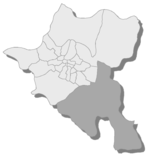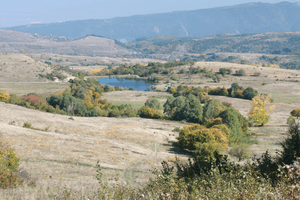Pancharevo

Pancharevo (Bulgarian: Панчарево) is a suburban district[1] located in the south-eastern parts of the Capital Municipality. As of 2006 it has 26,000 inhabitants. It is the largest region in Sofia with total area of 364,7 km². It includes the largest artificial lake in Bulgaria, the Iskar Dam as well as Lake Pancharevo and Pasarel Reservoir.




The districts consists of 10 villages, and Pancharevo is the municipal seat:
|
The districts offers excellent conditions for relax and tourism for the citizens of the capital. The three large dams have nice spots for fishing, camping and boat trips. There are many historical sights from the Middle Ages which include the ruins of the Urvich Fortress which was a sight of a desperate and unsuccessful battle against the Turkish invaders in the late 14th century. There are many monasteries and chapels, some of which lie in ruins since the fall of the Second Bulgarian Empire.
Village of Pancharevo is located 12 km southeast of the city center of Sofia, along Samokovsko shosse Blvd. It lies at 700 m. above sea level between Vitosha and Lozen mountains, and at the end of Pancharevo Gorge of the Iskar River. In Pancharevo Vitoshka Bistritsa River, sloping steeply from the highest parts of the mountain flows into Lake Pancharevo.
Pancharevo village construction in mostly modern suburban houses all round the year, and gated and has good communications to the Ring Road, Business Park Sofia, Tsarigradsko road and Sofia Airport.
Pancharevo mineral springs were probably known of the Thracians, who founded a settlement named Rilyanik, meaning abundant spring. Later, depending on their behalf period transformed. In Romans - Bathrooms Cesare / Royal /, when they were well supported by the aristocracy and the local population, and around them formed a rich imperial estate with vines. Bulgarians called them "Bathrooms Tsarevo, and the Turks - Bandzharevi and around them had famous Kina-Pashov farm.
In Pancharevo area have remained significant traces of the Roman Empire. Then it was built mineral bath which had seven pools. There is reason to believe that both the springs in Sofia and in Pancharevo has practiced the cult of the god-physician Asklepius and the nymphs, as both places were found fragments of bas-relief of three nymphs. Over bath Gradishteto in the area found the remains of Roman buildings and security fortress designed to keep the barbarian invasions of the access routes and Serdica Iskar Gorge, in the direction of Samokov, but unfortunately no more extensive archeological studies are performed later in area.
Pancharevo was first mentioned in the 16th-century Urvich Collection as ПАНЧАР, ПАНЧАРЄВѠ, ПАНИЧАРЬ. Those early references allow linguists to derive the name from the noun pan(i)char, "bowl maker", itself from the noun panitsa ("bowl"). Panitsa might be a geographical term referring to a concave place.[2]